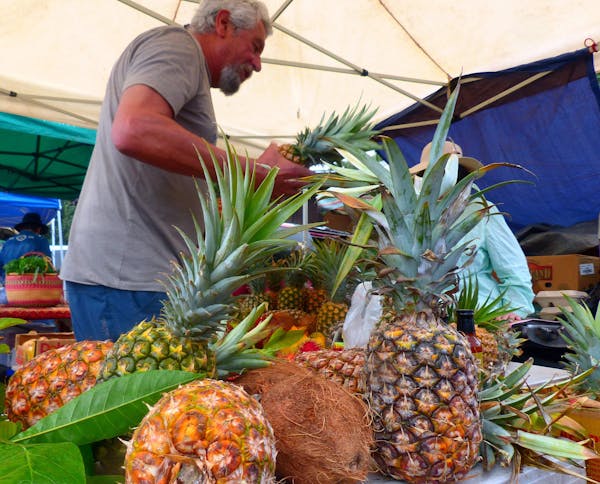The info desk staffer at Hawaii Volcanoes National Park gave me a patient and slightly sad look.
Yes, he could tell me how to get to the park's active lava flow. Yes, it was possible to get there before dark.
"But you might want to know," he said softly, as he traced the route on his topographical map, "a guide died there two weeks ago. People here are still getting over that."
It was mid-February on the Big Island of Hawaii, three months before Kilauea Volcano would burst into the news with dramatic video of lava spewing from fissures, destroying houses and roads. The eruption would close Hawaii Volcanoes National Park for more than three months and knock out a portion of the island's peak-season tourism revenue. But on most of the island, workaday life went on as usual. Kilauea has been active since 1983, adding more than 570 acres of land to the Big Island.
On an island known for its driving times — getting to many places on the two-lane roads took an hour or more — an active volcano on one side meant little more than extra haze elsewhere.
Everywhere we went on the Big Island, we found signs of an island still writing its geological story.
On our first day trip north of Kona, where we had rented a house for the week, the highway snaked through miles of black lava fields filled with jagged rock, boulders and smooth channels from old flows.
Further up the coast, we saw spiky grasses, scrubby trees and signs for wild donkeys.
It reminded me more of the North Carolina coast than the rain forest I was expecting.
We were headed to Kekaha Kai State Park, hoping to find one of the quieter beaches popular with locals.
After jolting down an unimproved road in our rental minivan, we arrived at a tiny parking lot just as a downpour began. A final, barefoot sprint through the sand brought me to an active, swirling surf, where the water foamed up and curled around my toes as rain hissed on the surface.
On my way back to the car, I met a volunteer putting up fencing to protect endangered monk seals that had beached themselves for the day.
Kekaha Kai was a wild introduction to the Big Island — perfect for a group of outdoors-loving Minnesotans.
Hiking the caldera
On our day at Volcanoes National Park, tourists crowded the visitor center, filling it with a hubbub of languages. Outside, we jostled for photos of the dramatic sky and the white plumes of sulfur dioxide venting from the caldera.
The six of us had just finished hiking a dormant crater nearby, Kilauea Iki or "Little Kilauea."
The two-hour hike took us through a lush forest that was a riot of birdcalls as we wound down to the crater.
At the bottom, we encountered a blasted field of lava channels and rubble, punctuated by plants that thrive under harsh conditions, like the bright red lehua flower.
Parts of the landscape, with its sulfuric white clouds ghosting up from steam vents, looked like the surface of an alien planet.
Back at the visitor center, we were tempted by the chance to see a fresh lava flow. But with sunset in two hours, we decided the off-trail hike on jagged rock was too risky for our group, which included my 8-year-old nephew and 73-year-old mom.
By April, a friend was taking photos of dramatic red lava from the visitor center. By May, the park was closed, as the collapse of a magma lake in the crater set off a deeper eruption and thousands of earthquakes across the park.
During the most active part of the eruption, "we had about 18,000 earthquakes per month," park spokeswoman Jessica Ferracane said.
The park reopened in late September after months of trail repair and cleanup. Most of the popular trails are open, Ferracane said. But she added, "Things are changing here and the park's still settling."
Sea caves and lava tubes
We saw a third aspect of the Big Island's volcanic history during a scuba-diving trip with a Kona-area outfitter, Sea Quest Rafting & Snorkeling Adventures.
As we zipped along the coast to the Captain Cook Monument, our captain, Kendra Wilson, maneuvered the boat close to sea caves and an old lava tube — one of which extended more than a mile deep. When we finally reached Kealakekua Bay, the red iron-tinged lava cliffs were a backdrop as we dove into the crystalline blue-green water.
I recently reached Wilson to check on conditions in the area. She said the news coverage of Kilauea's eruption had a big impact on the island's tourism-driven economy over the summer.
"The first two months of summer, we're usually at maximum capacity, everything's booked and sold out," she said. This year, bookings were "at 60 percent of what they usually are."
As the news coverage died down, bookings picked up a little, and tour operators hope for a rebound in 2019.
One upside to the end of the eruption? Without the volcanic fog, or vog, the island's air quality is the best it's been in decades, Wilson said.
Big Island's pull
I hadn't meant to fall in love with the Big Island. I'm a winter-loving Minnesotan who cherishes time in the North Woods.
But a week on the island, with its 70-degree days, its laid-back beaches and the scent of allspice everywhere in the air, loosened up some winter-blasted part of me I hadn't realized I was holding close.
As I rode the airport shuttle to my flight home from Honolulu, the driver chuckled when I said I'd missed a chance to see both snow — on Mauna Kea — and lava on the same trip.
"We've got everything here," she said. "Fire and ice. Where else can you find both in one place?"
Trisha Collopy • 612-673-4644
